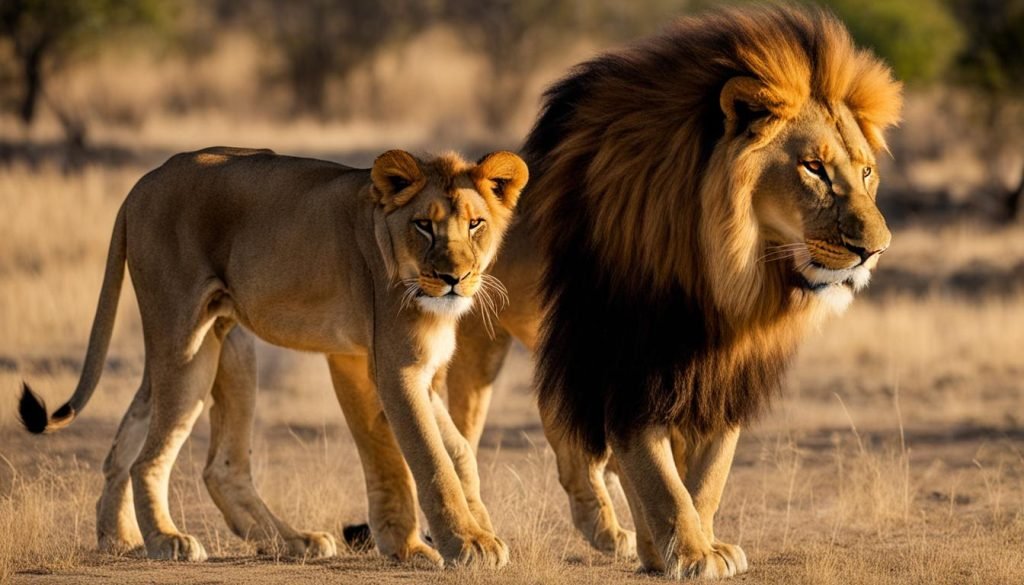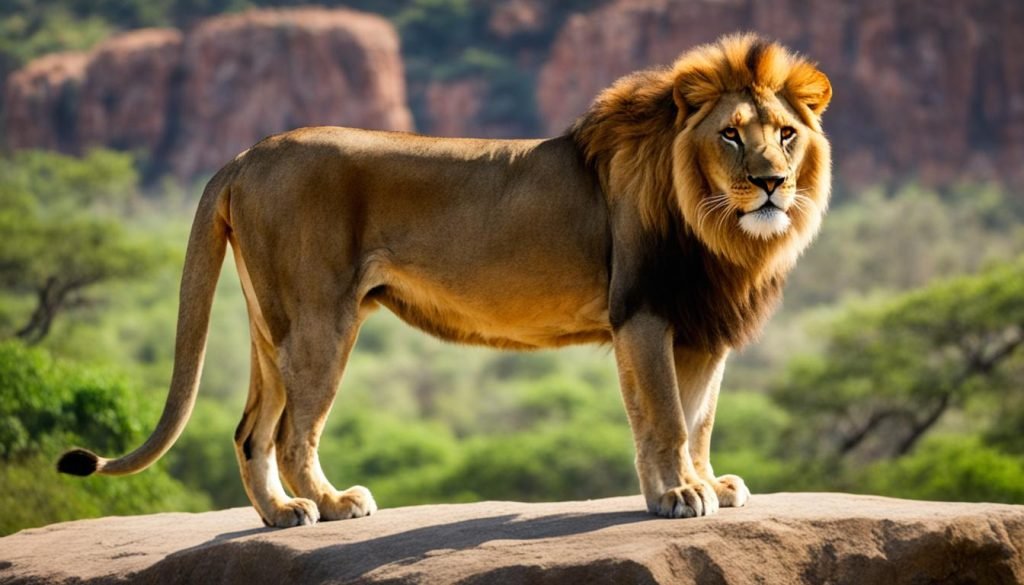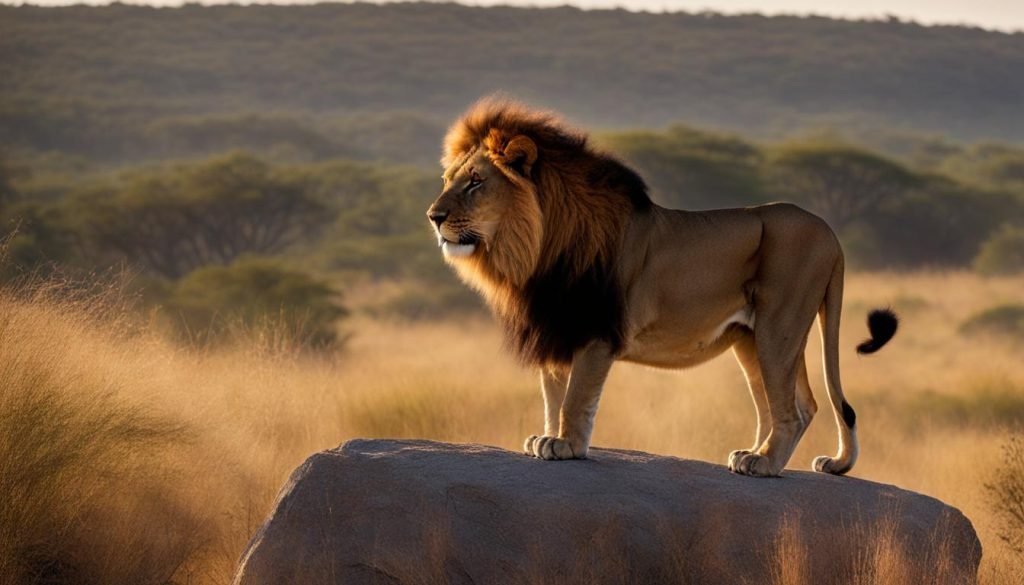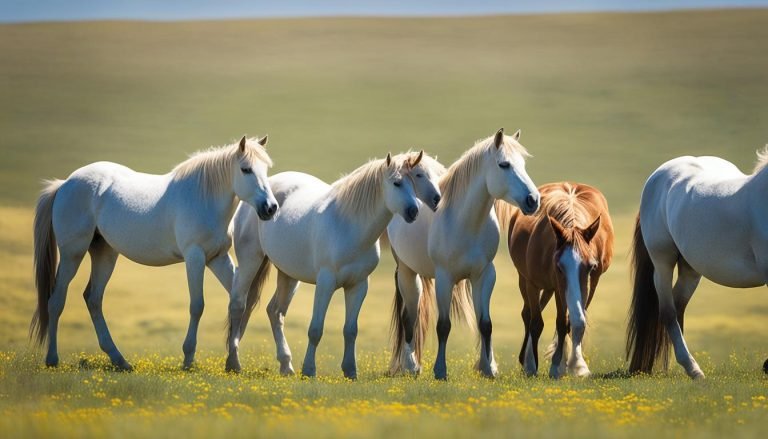How Do Lions Communicate With Each Other?
Lions are majestic creatures that have fascinated humans for centuries. From their impressive manes to their powerful roars, they capture our attention and inspire our imaginations. But have you ever wondered about the intricate ways that lions communicate with each other?
Communication is an essential part of lion social behavior, and they utilize a complex system of signals to convey information within their pride and to interact with other lions. From vocalizations and visual displays to scent marking and body language, lions have a diverse range of communication techniques.
So, How Do Lions Communicate With Each Other? Join us as we explore the fascinating world of lions.
Key Takeaways:
- The complex system of lion communication involves vocalizations, visual signals, scent marking, and body language.
- Lion communication plays a crucial role in maintaining social bonds, coordinating hunting efforts, and defending territory.
- Lions have specific vocalizations for different messages, such as territorial roars, contact calls, and mating calls.
- Visual signals include body language, facial expressions, and tail movements through which lions convey dominance displays and submissive gestures.
- Scent marking helps lions leave their mark on their territory and communicate with other lions.
Lion Communication: How Do Lions Communicate With Each Other?

Lions are known for their social behavior and effective communication. In this section, we will provide an overview of lion communication, which is crucial to their survival as a species.
Communication is fundamental to lion social behavior, as it enables them to coordinate hunting efforts, maintain a cohesive pride structure, and defend their territory.
Lions use a variety of patterns and signals to convey messages within their pride. These communication patterns determine the hierarchy and roles within the pride. For instance, male lions communicate their dominance through roaring, which establishes their position in the pride.
The following table provides an overview of lion communication patterns:
Visual Signals
Visual signals are crucial to lion communication, as lions use their body language and facial expressions to convey messages. For instance, when lions greet each other, they rub their faces and heads against each other to strengthen social bonds. On the other hand, a submissive lion will crouch down and avoid direct eye contact as a sign of submission.
Roars
Roaring is perhaps the most iconic form of lion communication. Male lions use roars to mark their territory, establish their dominance, and attract mates. Prides also have different types of roars to communicate with each other, from contact calls to territorial roars.
Scent Marking
Scent marking is another critical aspect of lion communication. Lions use their urine, feces, and other secretions to mark their territory and communicate with other lions. Scent marking helps lions identify each other and determine the presence of other prides in the area.
Cubs and Maternal Communication
Maternal communication is essential to the development of lion cubs. Lion mothers teach their young how to hunt and interact with their environment, often through vocalizations and play behavior. Cubs also communicate with each other through playful interactions, which help them develop vital social skills within the pride.
Overall, lion communication is a fascinating and complex topic that is crucial to their survival. Understanding the different forms of lion communication and the patterns and signals they use can provide valuable insights into their behavior and social structures.
Lion Vocalizations: The Power of the Roar

One of the most iconic sounds in nature is the roar of a lion, which can be heard up to five miles away. Lions use vocalizations to convey important information to other members of their pride, as well as to defend their territory from intruders.
There are three main types of lion roars:
- Territorial roars – These loud, deep roars are used to announce their presence and protect their territory from other lions. They can be heard from up to five miles away and are meant to warn intruders to stay away.
- Contact calls – These softer, shorter roars are used to locate other members of their pride when roaming or during a hunt. They act as a form of communication and help to coordinate group movements.
- Mating calls – Female lions make high-pitched calls when in estrus, signaling their availability to males within the pride. Male lions may also roar to signal their interest in mating.
Lion vocalizations are not only powerful, but they also convey different messages depending on the tone, pitch, and volume. Research has shown that lions use vocalizations to communicate with each other in a highly nuanced way, demonstrating the complex social structures and interactions within a pride.
“The roar of a lion is the result of the anatomy of its vocal system, which features an enlarged larynx and a specially adapted hyoid apparatus.”
In addition to vocalizations, lions also use other forms of communication to convey messages. In the next sections, we will explore lion visual signals, scent marking, and communication within and between prides.
Visual Signals: Reading Lion Body Language

While vocalizations play a crucial role in lion communication, it is their body language that often speaks the loudest. Lions use a variety of visual signals to convey messages within their pride, from dominant displays to submissive gestures. Understanding these signals is key to deciphering the complex social dynamics of a lion pride.
One of the most recognizable visual signals is the erect mane of a male lion. This serves as an indicator of his age and dominance, with larger manes indicating a stronger and more dominant male. A male will also use his body posture, with a stiffened gait and direct eye contact, to assert his dominance over other males in the pride.
Female lions also use their body language to communicate with other members of the pride. During hunting or territorial defense, females will coordinate their movements and maintain tension through subtle visual cues, such as tail flicks and ear twitches, to ensure a successful effort. When approaching her cubs, a mother lion may listen and sniff their scent before giving them visual confirmation that it is safe to approach.
Did you know? A lion’s tail is also an important visual signal, with the position and movements conveying different messages. For example, a lion holding its tail aloft signals confidence and aggression, whereas a tail tucked between the legs indicates submission or fear.
Recognizing and interpreting lion body language is crucial for researchers and conservationists who work with lions. By understanding the subtle visual signals within a lion pride, we gain insight into their social dynamics and can better protect these magnificent animals.
Scent Marking: Leaving Their Mark

While vocalizations and visual signals play an essential role in lion communication, scent marking is equally crucial. Lions are known for their distinctive urine odor, which they use to mark their territories and communicate with other lions. But why do lions scent marks, and how do they do it?
Lions mark their territory for several reasons, including establishing dominance, attracting potential mates, and announcing their presence to other lions. Lions use a combination of urine, feces, and glandular secretions to scent marks. Male lions have a distinctive mane that serves as a visual signal of their dominance, while females use their urine to mark their territory.
Other lions interpret these scent signals through their vomeronasal organ, a sensory organ located in the roof of their mouth. This organ detects chemical signals, allowing lions to differentiate between familiar and unfamiliar individuals and determine their sex, reproductive status, and hierarchy within the pride.
Scent marking is also an essential aspect of lion social behavior, helping to reinforce bonds within the pride and coordinate hunting efforts. By marking territory and leaving scent trails, lions can communicate their location and movements to other members of the pride without the need for vocalizations or visual signals.
Communication Within the Pride
In lion social behavior, the pride plays an important role as a tightly-knit group that relies on effective communication to thrive. Within a pride, lion pride communication involves various forms of vocal and visual signals, which enable these big cats to coordinate their actions, maintain social hierarchy, and build strong relationships with each other.
At the heart of lion pride communication patterns is the roar. Lions use different types of roars to convey specific messages within the pride, such as warning signals, contact calls, mating calls, and territorial warnings. The roar is not just a vocalization, but also a form of body language that involves visual displays of dominance, such as standing upright or puffing out the chest while roaring.
| Lion Role | Description |
|---|---|
| Alpha Male | The majority of a pride consists of lionesses who work together to hunt, care for, and protect cubs, and maintain social bonds. In the pride, females often have specific roles, such as hunting for specific prey or nursing cubs. |
| Females | The majority of a pride consists of lionesses who work together to hunt, care for and protect cubs, and maintain social bonds. In the pride, females often have specific roles, such as hunting for specific prey or nursing cubs. |
| Cubs | Young lions rely heavily on communication with their mothers to learn and develop social skills. Cubs also engage in play behavior as a way to practice and reinforce their communication skills. |
Lion pride communication also involves the use of visual signals such as tail movements, facial expressions, and body posture to convey messages. Dominant lions may display aggressive postures such as arching their back and lowering their head, while submissive lions may lower their heads and bodies and lick the other lion’s mouth or paws as a sign of deference. Eye contact is also an important part of lion communication, and lions use it to signal aggression or submission.
Effective communication within the pride is crucial for maintaining social harmony and cooperative hunting efforts. Through these complex communication patterns, lions can convey their needs and emotions to each other, ensuring the survival and success of the pride.
Communication Between Prides: Intra and Inter-Territorial Interactions
Communication between prides is a crucial part of lion social behavior. Lions communicate with neighboring prides, both within their territory and during territorial disputes, using various vocalizations and visual signals. These interactions play a significant role in maintaining social bonds, defending territory, and regulating hunting activities.
Intra-Territorial Interactions
Within a pride’s territory, lions communicate using a range of vocalizations and visual signals. Contact calls are used to locate pride members, while low-pitched moans signal aggression or dominance. Lions also use visual signals like facial expressions, tail movements, and posture to convey dominance or submission. When hunting, they work together using coordinated movements to capture prey.
Inter-Territorial Interactions
When a lion pride encounters a neighboring pride, communication takes on a different form. Lions use a variety of vocalizations, including roars, growls, and snarls, to claim territory and warn off interlopers. Visual signals like erect manes and tail twitching also signal aggression or dominance. In some instances, physical confrontations may occur as the prides attempt to defend their territory.
Communication Beyond the Pride: Roaming Males and Outsiders
When it comes to lion communication, the dynamics between roaming males and outsiders are particularly fascinating. Lions are social creatures, but male lions often live outside the pride structure. These males form coalitions and work together to take over territories from other prides.
Roaming males and outsiders have unique communication patterns and signals when interacting with other prides and individuals outside their social group. For example, they use deep roars to announce their presence during territorial takeovers. These communication signals are critical to the success of their coalition formation and territorial takeover endeavors.
Communication Strategies
Roaming male lions and outsiders use a variety of communication strategies to gain an advantage over other males and prides. One of the most effective is vocalizations that indicate their presence in the area. These signals convey information about their size, power, and coalition structure. For instance, deep roars indicate a more extensive coalition, while soft grunts represent a smaller group.
Body language is also important in lion communication. Roaming males and outsiders use their body posture as a form of signaling during territorial encounters. They lower their heads and puff out their chests to demonstrate dominance, while submissive lions crouch and tuck their tails.
Coalition Formation
Coalition formation among male lions is critical for successful territorial takeovers. The communication between members of the coalition is vital to coordinate their efforts. They must communicate their position and tactics in a manner that avoids confusion and increases their chances of victory.
Once a new coalition has established dominance in the territory, communication between coalition members becomes much less frequent. The males focus on maintaining their dominance, while also avoiding confrontations with other prides and individuals.
Cubs and Maternal Communication
The bond between lion cubs and their mothers is one of the strongest in the animal kingdom. Maternal communication plays a crucial role in teaching and guiding the cubs as they grow and learn about the world around them.
From their first days of life, lion cubs begin to communicate with their mothers through vocalizations and body language. They use soft chirps and mews to indicate their hunger or discomfort and nuzzle and lick their mother’s face to seek comfort and attention.
As they grow older, lion cubs continue to develop their communication skills through play behavior. They practice pouncing and wrestling with their siblings, honing their hunting instincts and learning the nuances of physical communication with other lions. Cubs also communicate through visual signals, such as tail wagging and ear flattening, to convey important messages to their mother and siblings.
Maternal communication is vital in teaching cubs essential survival skills, such as how to hunt and avoid danger. Lionesses use a range of vocalizations, including low growls and snarls, to discipline their cubs and teach them proper behavior. She will also purr to reassure her cubs when they are scared or anxious.
The image below shows lion cubs playing and developing their communication skills through physical behavior and body language.
Understanding the importance of maternal communication in lion social behavior sheds light on the complexity and sophistication of lion communication and their ability to thrive as a social species.
Communication and Survival: The Adaptive Advantage
Effective communication is essential for lions to thrive in their environment. The adaptive advantage of lion communication is evident in their ability to coordinate hunting efforts, defend their territory, and maintain a cohesive pride structure. Lion social behavior heavily relies on communication, as it enables them to succeed in complex and dangerous environments.
For instance, efficient communication enables lions to hunt in groups, increasing their chances of capturing prey. By working together, they can take down larger animals, ensuring adequate food for the entire pride. Effective communication is also crucial for defending their territory against intruders. Lions use visual signals, vocalizations, and scent markings to warn intruders and secure their territory. Additionally, social behavior, including grooming and physical contact, improves group cohesion, keeping the pride together and being able to tackle challenges together.
The adaptive advantage of lion communication is evident in their survival and reproductive success. Effective communication enables them to form strong social bonds, work together, defend their territory, and hunt successfully, all leading to a greater chance of survival. It also allows them to maintain a stable pride structure, ensuring reproductive success by controlling mating opportunities and protecting cubs from outsiders.
“Communication is the key to a successful lion pride and ultimately, the survival of the species.”
Conclusion: Lion Communication
In conclusion, understanding lion communication is crucial to appreciating the complexity and sophistication of their social behavior. Through this article, we have explored the various forms of lion communication, including vocalizations, visual signals, body language, and scent marking. We have seen how these signals are used to convey different messages within the pride, among neighboring prides, and when interacting with outsiders.
Our exploration of lion communication patterns has revealed how they use different vocalizations to communicate territorial boundaries, coordinate hunting efforts, and attract mates. We have also learned how lions use body language to display dominance or submission within the pride and how scent marking plays an important role in establishing territorial boundaries.
The importance of communication in lion social behavior cannot be overstated. Their ability to communicate effectively allows them to coordinate their efforts, defend their territory, and maintain a cohesive pride structure. It also plays a crucial role in the teaching and guidance of cubs by their mothers.
By unlocking the secrets of lion communication, we gain a deeper understanding of these magnificent creatures and their role in the African savannah ecosystem. We must continue to study and protect them, ensuring their survival for generations to come.
More About Lions:
- What Do Lions Need To Survive? Habitat, Diet & More
- How Many Lions Exist in the World in 2024?
- How Long Do Lions Live? Wild vs Captivity
- Do Lions Eat Humans?
- Do Lions Have Predators? Lion Threats Explained
- What Do Lions Do All Day?
- What Do Lions Do During the Night?
- Where Do Lions Sleep?
- How Fast Can Lions Run?
- Can Lions Swim? Lion’s Swimming Ability Examined
- Cannibalism in Lions: Do Lions Eat Other Lions?
- How Long Are Lions Pregnant? Gestation Period
- Do Lions Hibernate During Winter?
- How Big Can Lions Get? Lion Size Chart
- How Much Do Lions Weigh? Lion’s Weight Revealed







